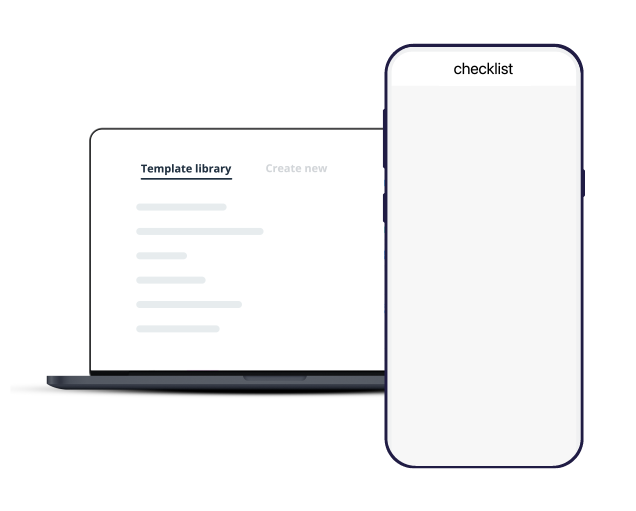Our employee attendance policy template makes it easy to manage absenteeism and offers insight on creating and improving a company’s attendance policy.
Employee Attendance Policy Template

Make work flow with Connecteam’s digital forms & checklists
- Easily create digital forms and checklists for any task your team needs to complete on the job
- Boost accountability by having employees add a signature, image, or location stamp
- Save time by choosing from a variety of ready-made templates
- Instantly receive your team’s submissions and share reports within your organization
- Use AI to convert PDFs, Excel files, or images into digital forms in seconds—no manual work needed

Employee Attendance Policy Template
Whether you call it attendance management policy, absenteeism policy, tardiness policy or attendance policy, it’s all the same in the end. You expect your employees to be present for work, on time, every day they’re scheduled to work. Regular attendance and punctuality is key in order to work smoothly as a team and a company. Being late, tardy or absent will only cause disruptions and acts as a burden to co-workers.
What should you include in the employee attendance policy?
- Overview or scope of attendance policy
- Calculating absence infractions
- Differences in absenteeism and tardiness
- Unforeseen absences
- Failing to clock in and clock out
- What is good attendance?
- Responsibility of the manager
- Disciplinary actions
Be sure to include your employee attendance policy in your employee handbook and make sure your employees sign and date that they read and understand the employee attendance policy.
Our employee attendance policy template provides general guidelines and serves as a reference. All relevant local, state or federal laws may not be taken into account, therefore this does not act as a legal document. We do not assume legal liability that may arise from using this policy. Refer to legal counsel once you edit our employee attendance policy template to suit your company.
Employee Attendance Policy Template
- Overview of attendance policy
The employees of ABC Productions are expected to be present for work, on time, every day they are scheduled. Regular attendance and punctuality are crucial in order to keep your team and ABC Productions operating effectively and efficiently. Arriving late, arriving tardy, or absences can cause disruptions.
Our employee attendance policy clearly outlines what our expectations are regarding our employees’ coming to work.
- Calculating absence infractions
Tracking employee absences makes it easier to correct the problem or to carry out disciplinary actions if necessary.
- Absent with calls: 1 point
- Absent, no call: 2 points
- Tardy: ½ point
- Leaving early: ½ point
- Late return from lunch or break: 1 point (if over 30 minutes)
For each scheduled shift, employees have a five minute grace period at the start and end of the shift. Employees must report an absence by calling their direct manager and they must report each day that they are absent. If an employee fails to call at least one hour prior to a shift, this will result in a no call-no show (however there are exceptions, such as a car accident that prevents the employee from calling).
Attendance infractions will reset every six months or yearly (like vacation days).
- Differences in absenteeism and tardiness
Absenteeism is the frequent absence of an employee from their job responsibilities. Such as frequently not coming to work or not providing a doctor’s note when taking excessive sick leave.
Presenteeism is when you’re at work beyond your scheduled hours, even when the company does not require overtime. This will cause the employee to be overworked and will negatively impact productivity and job satisfaction. We want our employees to follow their schedule when arriving and leaving.
Tardiness is when an employee comes in late, takes longer breaks than entitled to and constantly leaves work early without a reason. We won’t mind arriving a little late one morning or leaving a little early, like on a Friday. However, we want you to follow your set schedule and to avoid causing disruption in the workplace.
All employees must monitor their work hours through our time tracking app, Connecteam. You must be diligent in recording your hours so that you will receive your salary.
- Failing to clock in and clock out
With Connecteam, employees are required to clock in and clock out for each shift. If employees have a problem recording a clock in or clock out time, they are required to inform a manager immediately. For employees who consistently fail to clock in or clock out, they are subject to receive disciplinary action or even termination.
- Unforeseen absences
Notify your manager as soon as possible if you cannot come to work and if your manager is not answering, contact HR. As a result, you should be able to use paid time off or sick leave to cover the absence, but make sure that you record this in Connecteam as soon as possible.
If you have an unexcused or unreported absence for longer than three days, we will consider this job abandonment. Inform your manager if you need to leave work early, for example, you have a doctor’s appointment or you have teacher-parent conferences.
There are circumstances where we will understand your being absent, even if you didn’t report it. These reasons usually will involve a serious accident or a family medical emergency. Your absence will be excused in these instances, however we may ask for some verification if necessary.
The following listed below are some examples of what we do not consider an excused absence:
- You woke up late, or your child woke up late.
- Stopping somewhere while on the way to work for personal reasons, like grabbing a cup of coffee.
- Traffic or public transportation delays, this excludes situations that resulted in closing of roads.
- Bad weather, this excludes extreme weather conditions such as tornadoes, blizzards, hurricanes and floods.
- Holidays or vacation days that were not approved.
- What is good attendance?
An employee who has less than four incidents of absenteeism or tardiness in a year is an example of an employee with good attendance. As such, this employee will receive an additional paid day off the next year.
Employees have a good attendance record based on the following:
- Consistently reporting to work.
- Arriving to work at the scheduled shift start time.
- Leaving work at the scheduled shift end time (unless paid overtime is required.)
- Remaining at work during working hours (excluding breaks.)
- Taking lunch or breaks that don’t exceed the expected length.
- Notifying their manager when needing to be absent or late.
- Being absent or late with good reasons only.
- Responsibility of the manager
It is the duty of the manager to monitor his/her employee’s attendance. If you notice an employee is consistently breaking the employee attendance policy, you need to schedule a meeting to discuss the actions. In the meeting, ask the employee is they are having issues with the schedule or if they need help creating a work-life balance. Flexible hours, working from home or time management training options could be a solution. If you believe that a mental health issue is causing absenteeism or tardiness, ask your employee to contact our [mental health professional] and discuss how you can help them.
If you believe that the employee is abusing their sick leave or is purposely tardy, you must inform HR and begin a progressive discipline process.
- Disciplinary actions
If a manager suspects that an employee is abusing their sick leave, said employee may need to submit doctor’s notes in order to avoid progressive discipline process. If an employee is found to be unintentionally tardy, then corrective counseling will the first step at finding a solution. We will take disciplinary action that goes up to and including termination if:
- Corrective counseling doesn’t work.
- You are willfully tardy.
- Your tardiness or absenteeism directly impacts your work.
Unexcused and unreported absences are not considered as hours worked therefore we will not compensate them.
Related Templates:
Issue an Employee Confidentiality agreement with our free template
Watch the video below to see it in action:

Ready to boost your efficiency with our pre-made templates?